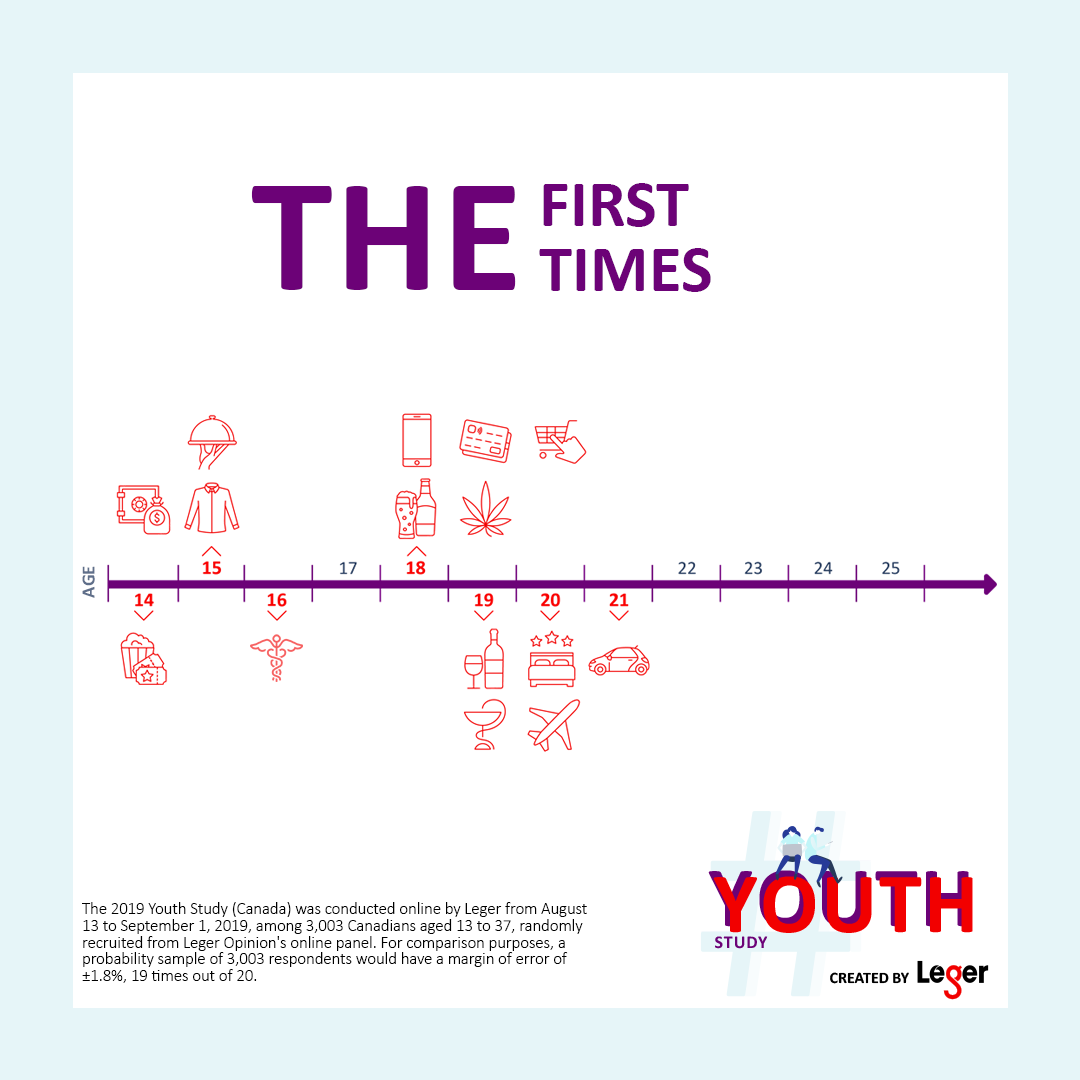When was the first time you purchased a movie ticket with your own money? Beer? A vehicle?
Thinking a little differently, do you know when young customers are making their first purchases of the products and services in your brand category?
Our 2019 Youth Study asked 3,003 millennials and members of Generation Z how old they were when they purchased a selection of products / services for the first time with their own money.
Here’s what they said:
Young Canadians (who are currently aged 13-37), first purchased each of the products/services below at the following ages (median values)…
- 14 years old: Movie ticket
- 15 years old: Restaurant meal, Clothing in a store, Bank account
- 16 years old: Product at a pharmacy
- 18 years old: Smartphone, Beer, Online product, Marijuana, Credit card in their name only
- 19 years old: Hard liquor, Wine
- 20 years old: Plane ticket, Rented a hotel room
- 21 years old: Car
Younger Canadians tend to begin purchasing less expensive items when they are aged 14-15, while larger purchases tend to be made from age 19-21, as may be expected.
The first purchase: an opportunity to build a relationship
Someone’s first time purchasing something with their own money offers you the opportunity to begin a longstanding relationship between them and your brand. You can help this person feel secure and begin to build loyalty. If they have a positive experience and are satisfied, it may be their first purchase in a long chain of purchases from your brand. However, if the experience is negative, they may flock to a competitor, never to be seen again.
The first purchase is also an opportunity to begin collecting customer data, so that you can provide tailored recommendations that better meet your customers’ needs, further assisting with building loyalty and providing your customers with a great experience. For example, certain loyalty programs monitor the products customers purchase, and provide them with coupons for these items that can be used when they shop in the future, or recommendations for similar products they may also enjoy. Through all of this, the protection of customer privacy is of the utmost importance.
But, the times are changing…
Not all generations interact with brands in the same way, and technology has a large part to play in this.
For example, as mentioned by Alex Shvarts, CTO of FundKite, compared to millennials and Generation Z, the baby boomer generation had fewer opportunities to hop from brand to brand three decades ago: partially because simply fewer brands existed, and because it was more difficult to discover new brands without easy access to the internet.
In the words of Michael Dimock, president of the Pew Research Centre,
“Social media, constant connectivity, and on-demand entertainment and communication are innovations millennials adapted to as they came of age. For those born after 1996, these are largely assumed.”
One impact of this (as noted by Mary Hanbury of Business Insider) is that getting brand loyalty from Gen Zers can be extremely difficult. There is a seemingly endless stream of brand options available, and it’s easy to find them in a fraction of a second online. This group “ha[s] largely been made skeptical by their ability to verify almost anything online,” with experts noting that “transparency and authenticity” are very important for this generation.
To be present when your customers begin to form their buying habits (and to help facilitate long term loyalty with them), you need to know when they will be dealing with you for the first time. We’ve come up with a “first time” timeline to help you get it right.
Click the button at the bottom of this page to contact us for more information!
READ OUR OTHER ARTICLES ABOUT THE 2019 YOUTH STUDY
- Analyzing young Canadians– who are they really?
- Discover the 5 types of anxiety experienced by young Canadians
- Why do young Canadians buy local?
About This Study
The 2019 Youth Study (Canada) was conducted online by Leger from August 13 to September 1, 2019, among 3,003 Canadians aged 13 to 37, randomly recruited from Leger Opinion’s online panel. For comparison purposes, a probability sample of 3,003 respondents would have a margin of error of ±1.8%, 19 times out of 20.
Sources
https://www.pewresearch.org/fact-tank/2019/01/17/where-millennials-end-and-generation-z-begins/
https://www.businessinsider.com/gen-z-shopping-habits-kill-brands-2019-7

